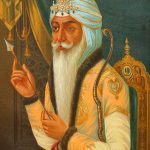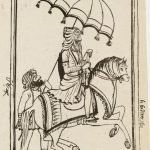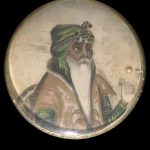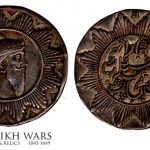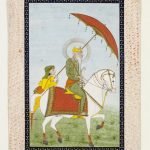- Poatrait of Ranjit Singh.
- Ranjit Singh on horseback, facing right, a follower holding a state umbrella© Victoria and Albert Museum, London.
- Order of Merit with a Portrait of Ranjit Singh. © Victoria and Albert Museum, London.
- Painting, paint on ivory, a miniature portrait of Maharajah Ranjit Singh, ruler of the Punjab. ca. 1850 – ca. 1870. © Victoria and Albert Museum, London.
- A twelve pointed sun-burst star with the head of Maharaja Ranjit Singh facing right in the centre. Date 1837. © Trustees of the British Museum
- Ranjit Singh-Painted in opaque watercolour and gold on paper. © Victoria and Albert Museum, London.
Background
Ranjit Singh, (1780-1839) was born in Gujranwala and became Maharaja (1801–39) of the Sikh kingdom of the Punjab. Ranjit Singh was the first Indian in a millennium to turn the tide of invasion back into the homelands of the traditional conquerors of India, the Pashtuns (Afghans), and he thus became known as the Sher-e-Punjab or Lion of the Punjab. At their height, his domains extended from the Khyber Pass in the northwest to the Sutlej River in the east and from the Kashmir region at the northern limit of the Indian subcontinent southward to the Thar (Great Indian) Desert.
He was the only child of Maha(n) Singh(1756–1790) on whose death in 1792 he became chief of the Sukerchakia Misl. The various Misls or confederacies had been battling the invaders of Punjab during the eighteenth century. The high point being the raising of the Sikh Battle standard by Jassa Singh ( Head of the Buddha Dal and Ahluwalia Misl), Baghel Singh (Karora Singhia Misl) and Jassa Singh ( Ramgharia Misl) at the Red Fort in Delhi in 1783.
Ranjit Singh’s inheritance included Gujranwala town and the surrounding villages, now in Pakistan. He married the daughter of a chieftain of the Kanhaya Misl and for many years his affairs were directed by his ambitious mother-in-law, the widow Sada Kaur. A second marriage, to a girl of the Nakai Misl, made Ranjit Singh preeminent among the clans of the Sikh confederacy.
In July 1799 he seized Lahore, the capital of the Punjab (now the capital of Punjab province, Pakistan). The Afghan king, Zaman Shah, confirmed Ranjit Singh as governor of the city, but in 1801 Ranjit Singh proclaimed himself Maharaja of the Punjab. He had coins struck in the name of the Sikh Gurus, the revered line of Sikh leaders, and proceeded to administer the state in the name of the Sikh commonwealth. A year later he captured Amritsar (now in Punjab state, India), the most-important commercial entrepôt in northern India and sacred city of the Sikhs. Thereafter, he proceeded to subdue the smaller Sikh and Pashtun principalities that were scattered throughout the Punjab.The timely arrival of Akali Phula Singh (1761 – 1823) ensured he had the support of the religious and military order the Akali Nihangs
His later forays eastward, however, were checked by the British, he agreed to expel a Maratha force that had sought refuge in the Punjab. The English then thwarted his ambition to bring together all of the Sikh territories extending up to the vicinity of Delhi. As a result in 1809 he signed the Treaty of Amritsar, which fixed the Sutlej River as the eastern boundary of his territories. Eseentially The Sikh Empire was divided into four provinces: Lahore, Multan, Peshawar, and Kashmir from 1799 to 1849.
Europeanisation of the army
All Ranjit Singh’s conquests were achieved by Punjabi armies composed of Sikhs, Muslims, and Hindus. His commanders were also drawn from different religious communities, as were his cabinet ministers. In 1820 Ranjit Singh began to modernize his army, using European officers.He recruited two Frenchmen, Jean Francois Allard(1785 – 1839) and Jean Baptiste Ventura (1794 – 1858) who had served under Napoleon, to take over the training of his cavalry and infantry, respectively. Thereafter many foreigners French, English, Italians, Greeks, Americans, and Eurasians were employed on very generous terms. Many of these foreign officers rose to high positions. General Allard who was decorated with the order of the Star of the Prosperity of the Punjab. He died in Peshawar in 1839. General Ventura (1794 -1858) rose to the highest position and continued to serve the Darbar after Ranjit Singh`s death. He was given the title “Count de Mandi.” Claude Auguste Court (1793 – 1880), another Frenchman and the Italian, Paolo de Avitabile (1791 – 1850) who joined service in 1827, also rose to high positions.
The Fauj-i-Ain was a branch of the Sikh Khalsa Army and was the regular army of Maharaja Ranjit Singh of Punjab. It contained infantry, cavalry and artillery units. This included the the Fauj-i-Khas which consisted of elite soldiers.
Key battles
13 July (1813), Battle of Attock-This was the first significant Sikh Empire’s victory over the Durrani Empire (Their empire was founded in 1747 by Ahmad Shah Durrani with its capital at Kandahar, in present-day Afghanistan).
March – 2 June (1818), Battle of Multan.-Sikhs decisively defeated the Durranis and captured Multan. Regions to the east of Indus virtually came under Sikh influence.
3 July (1819), Battle of Shopian-The decisive victory of the Sikhs led to the end the five centuries old Muslim rule in Kashmir. The Afghan governor Jabbar Khan fled and Kashmir became a province of the Sikh Empire.The famous Gun known as the Zamzama (also known as Bhangi di tope-Gun of the Bhangis) was used in the battle, the Akali Nihangs under the leadership of Akali Phula Singh fought mercilessly and the actions of Akali Sadhu Singh (who died in the battle) were instrumental in the defeat of Nawab Muzaffar Khan.
14 March (1823), Battle of Nowshera-The battle was a decisive victory for the Sikhs and led to their occupation of the Peshawar valley. Generals who fought in the battle included including Hari Singh Nalwa(1791–1837) , Ventura and Jean-Francois Allard. Akali Phula Singh became a martyr (Shaheed) for the Sikhs at this battle.
6 May (1834). Battle of Peshawar-The battle was fought under the command of Hari Singh Nalwa, finally capturing Peshawar and ending the eight hundred years of Muslim rule.
30 April (1837), Battle of Jamrud-Although the Afghans were defeated and repulsed, the Sikhs lost Hari Singh Nalwa halting the westward expansion of the Sikh Empire.
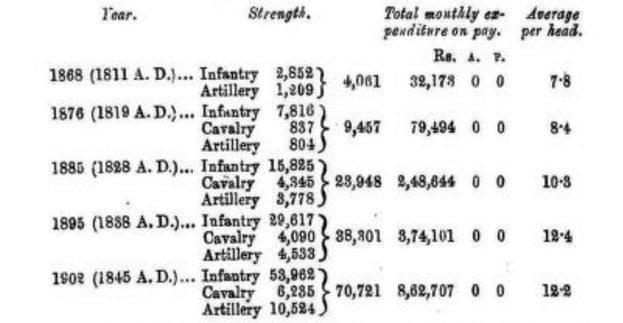
Size of the army according to Sita Ram Kohli (Catalogue of the Khalsa Durbar Records). These figures have differed according to different sources.
Patron of the arts
The Maharaja was also patron of the arts and employed many artisans from Kashmir. Murals and frescos of this period were to be seen in the Maharaja’s palace, the Sheesh Mahal at Lahore, his residence at Rambagh Gardens Amritsar, and at the shrine Baba Atal and most notably at Harimandir Sahib (Golden Temple) at Amritsar. The holiest shrine of the Sikhs was given a ‘gold’ make over. He also ensured that new recensions of Guru Granth Sahib , the holy scripture of the Sikhs were decorated with intricate designs. The education system of the Punjab improved during this time also.
The Treasuries
The Sikh empire became very rich after the numerous conquests together with the tributaries that were paid by the various chiefs. As a result the Sikh treasuries at Lahore and Amristar became a repository of riches as well a treasure house containing artefacts from the time of the Guru’s and other Sikh warriors. These artefacts after the annexation of the Punjab in 1849 would be seized by the British and taken to the UK. Many of these relics can be seen in museums across the UK including the golden throne of Maharaja Ranjit Singh. The prized possession however was the fabled diamond the Koh-i-noor which was taken from Shah Shuja (Durrani).
After 1839
The Maharaja however did not leave any capable successor as a result after his death in 1839 the empire was severely weakened by internal divisions and political mismanagement. The rise of Rajas Lal Singh (1798-1875) and Tej Singh(1799-1862) within the court would lead to straining relationships between various parties in the Court. Maharani Jindan Kaur another consort of the Maharaja, also rose to prominence and willed Duleep Singh the son of Ranjit Singh to be given the title of Maharaja. After the assassinations of four of his predecessors, he came to power in September 1843, at the age of five . This disorder was not only seen as a threat but an opportunity for the British East India Company,as a result they started building up their provisions and forces close to the Sutlej river. It would only be a matter of time when the British and the Sikh would go head to head.
Sources and further reading
Enclylopaedia of Sikhism 4 vols-Punjabi University Patiala
Sita Ram Kohli-Catalogue of the Khalsa Durbar Records
Britannica.com

